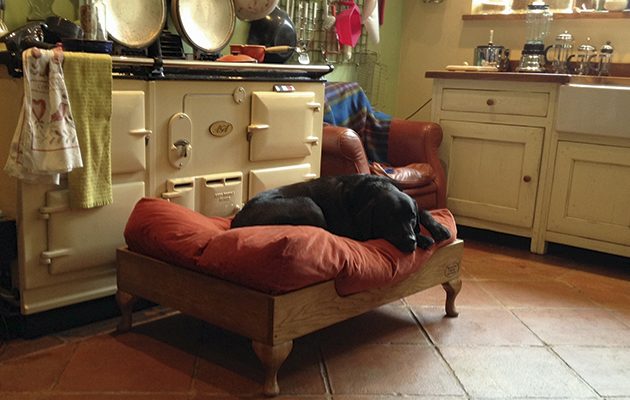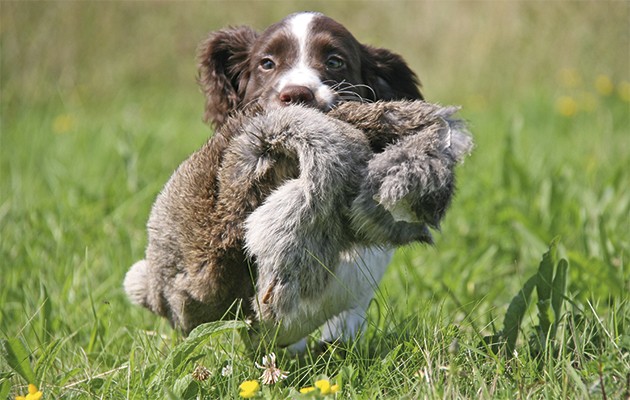With gundog owners facing a seemingly endless array of ‘must-have’ gear, David Tomlinson draws on years of hands-on experience to select his essential gundog products
Last month, I was walking by a local fishing lake when I was amused to see a carp fisherman struggling to wheel his equipment along the path. I was tempted to ask him whether he really needed so much kit but he was clearly keen to get fishing, so I didn’t delay him. Modern carp fishermen need (or think that they need) an awful lot of gear to catch a fish. It set me thinking about how much kit the successful gundog handler requires, apart from the dog itself. Over the years, I’ve tried, tested (and discarded) an awful lot of stuff, so here’s my view of what gundog products you really need, what you might like, and what you and your dog, or dogs, can live without.
ESSENTIAL GUNDOG PRODUCTS – WHAT TO BUY?
HOUSING AND DOG BEDS
Housing for the dog is the first and most basic requirement. I still have the Neaverson kennel I bought more than 25 years ago, now in its third location. It is a top-quality product, so has worn well, though it still shows the tooth marks of a friend’s labrador that only spent a day in it. It housed three generations of Tomlinson spaniels and none of them ever gnawed it. Today, it stores gardening equipment, as my current spaniel is an indoor dog. A kennel is useful, especially so if you have lots of dogs, but not essential.

Kennelled dogs are usually bedded on straw, wood shavings or Vetbed. I’ve used all three and even tried a variety of different straws (oat straw was best, barley best avoided), but found Vetbed the most practical. Tough and quick to dry, it’s a highly versatile product, as it can also be used indoors, such as in front of the AGA, as well as in the car. With indoor bedding, the choice is so wide it’s hard to know where to start. My dogs have always been happiest with beanbag-type beds and our favourite is a British-made Barka Parka. There’s the option of waterproof covers, while the beds are easily topped up with fresh beans, making them extremely practical. Definitely recommended.
LEADS

Every dog needs a lead, and I’ve always used rope slip leads. I avoid slippery nylon and opt instead for those made from marine rope. Choose the length and thickness with care. I now favour a 140cm-long lead, with a rope thickness of 8mm. I used to like chunky 12mm versions, but ropes this thick are best for securing yachts. Devon-based KJK Ropeworks offers a wide choice of leads. I recommend buying bright colours, such as shiny yellow, as you are less likely to lose the lead when you drop it in the grass. Working gundogs shouldn’t wear harnesses, which only encourage them to pull.
WHISTLES
The whistle is an essential tool of the gundog trainer. ACME is the market leader and has been making whistles since 1870. I’ve always used a 210½. Labrador handlers generally prefer a 211½, although I’m not sure why. Silent whistles are rarely used by gundog handlers, possibly because it’s so frustrating using one when the dog ignores it. These days, whistles come in a variety of colours, while the price remains below a tenner. You can use string to hang a whistle around your neck, but I have a kangaroo-leather braided lanyard made by Lagopus. It’s 20 years old and still looks as good as new.
DOG COATS
A relatively modern innovation in the gundog products world is the dog coat. I was laughed at when I first rugged-up my spaniels after a day’s shooting, but now it’s standard practice. Coats come in a variety of shapes and fabrics. For a working gundog, you want a coat that wicks the moisture out of wet fur. Ruff and Tumble offers some of the best drying coats you can buy. Neoprene coats that can be worn when working can also be invaluable on filthy winter days: mine came from Everything Outdoor, based at Holkham in Norfolk.
TRAINING DUMMIES
I recently had a clear-out of my training dummies, many of which were getting quite old. Recent years have seen the introduction of a wide range of interesting dummies, many bird shaped to give a more realistic retrieve to a trainee gundog than the old green canvas tubes stuffed with sawdust. Gundog products specialist Dog & Field has a particularly fine range of dummies, with its Original Clone series. This includes pheasant, partridge, snipe and pigeon, while each one has a toggle that makes throwing them much easier. One piece of kit that I was happy to get rid of was my dummy launcher, powered by a .22 blank. Noisy with unpleasant recoil, these launchers can make dogs gun-shy.

For the serious trainer, the ultimate piece of kit is the Auto Launch Remote Control Dummy Launcher. Made in the UK and marketed by Sporting Saint, it allows the trainer to remotely launch dummies and replicate the sort of retrieves dogs will encounter in the shooting field. At £1,525, it’s aimed at professionals and gundog training clubs. The price of this launcher pales into insignificance compared with the most desirable gundog accessory: the double-cab pickup truck. Such vehicles have become de rigueur with the top triallers, but an old-fashioned van or estate car is almost as practical and much less expensive, both to buy and to run.





